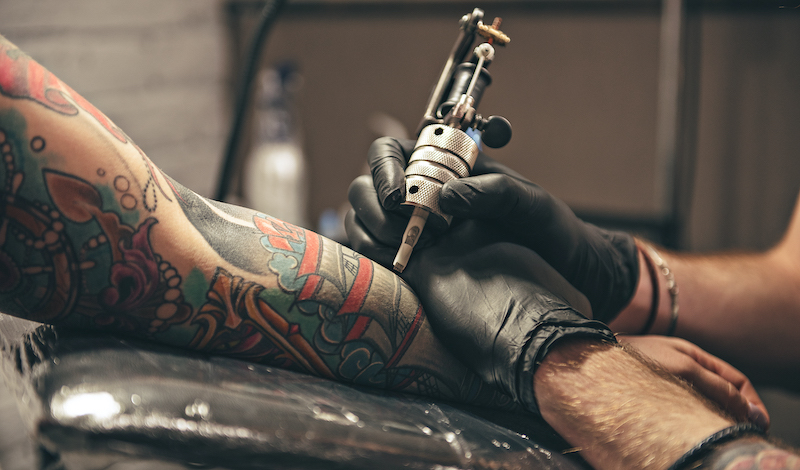
FDA should increase its regulatory oversight of tattoo ink safety.
Nearly one third of Americans have a tattoo. Despite lingering stigma against tattooed individuals, the popularity of tattoos has increased in recent years.
But are safety regulations adequate to protect tattooed individuals’ health?
The act of tattooing is associated with several health risks such as the risk of skin infections, bloodborne diseases, and allergic reactions. People can reduce the risk of tattoo-related complications by going to a reputable, state-regulated tattoo artist and by practicing proper hygiene and aftercare.
Some risks associated with tattoos, however, are unavoidable. Although many states regulate the tattoo process by establishing sterilization, sanitation, and safety standards for the administration of a tattoo, the safety of tattoo ink faces much less regulatory scrutiny.
Research into the safety of tattoo ink is limited. Although the link between tattoo ink and cancer is unclear, the pigments are composed of up to 100 different chemicals, including chemicals that may increase the risk of cancer. A 2017 study indicated that toxic elements in tattoo ink can migrate and deposit in the lymph nodes, which may increase risk of chronic inflammation. Some scientists have criticized the lack of research into tattoo ink safety and advocate increased regulatory oversight.
In the United States, the tattoo ink industry is largely unregulated. The safety of tattoo ink is technically monitored by the U.S. Food and Drug Administration (FDA), but FDA has taken a passive approach to regulating ink safety.
Under the Federal Food, Drug, and Cosmetic Act, FDA categorizes tattoo ink as a cosmetic product. Some products—such as fluoride toothpaste—may be designated as both a cosmetic product and a drug product, so they are subject to more stringent oversight. But tattoo ink is considered a purely cosmetic product, which means that FDA does not evaluate and approve tattoo ink products before they enter the market. Instead, FDA only intervenes in the tattoo ink market when it happens to learn of an issue with a specific product.
Tattoo ink manufacturers are required to adhere to labeling requirements set out by the Fair Packaging and Labeling Act. Tattoo ink manufacturers must include the ingredients, net contents, and safety warnings in their labels. Label requirements are intended to help consumers make informed decisions about their cosmetic purchases. But the vast majority of tattoo inks are purchased in bulk by tattoo studios, so consumers rarely, if ever, have the opportunity to review the tattoo ink labels.
Even when an issue arises with a cosmetic product, FDA has limited authority to detect and address it. FDA only responds to reported incidents, so its response is only as effective as its reporting system. Scholars have criticized the cosmetics reporting system, arguing that a voluntary reporting system is insufficient. In addition, FDA lacks the authority to require a recall for cosmetic products. FDA can only request that they do so.
For example, when FDA learned in 2019 that three tattoo ink products had been contaminated with bacteria, it issued an alert and coordinated with the ink manufacturers, which voluntarily recalled their products, to remove the inks from the market.
This lack of FDA oversight does not mean that all tattoo inks are toxic, but it should give tattoo artists and recipients pause. It also raises an important question: Why is FDA doing so little to intervene?
FDA’s hands-off approach to tattoo ink safety may reflect the stigma associated with tattoos. Historically, individuals with tattoos in the United States were associated with negative stereotypes and faced social stigma. Although tattooing has become more prevalent in modern societies, many of the older stereotypes remain. For example, scholars have found that people view tattooed individuals as being less competent, less sociable, and more promiscuous. People with tattoos also face discrimination in the workplace and during the hiring process.
A preliminary study indicated that people with tattoos face health inequities. The study’s authors claim that insurers are less likely to cover adequately the health care costs of individuals who are perceived to be responsible for their illness, such as people who eat unhealthy diets or smoke.. They argue that this correlation between perceived responsibility and health care cost liability affects the tattooed community because tattooed people are perceived as choosing their stigma.
This perception can increase discrimination against the tattooed community and may be part of the reason why FDA has not increased its oversight of the tattoo ink industry. Because individuals with tattoos may be perceived as “responsible” for the risks to their health, FDA may undervalue the importance of ensuring tattoo ink safety.
FDA could increase its oversight of the tattoo ink industry through several pathways.
FDA could oversee at least some of the ingredients in tattoo ink using regulatory authority that it already has. Although FDA does not require most cosmetics to go through pre-market approval, it does pre-approve color additives—substances that are capable of imparting color to a food, drug, cosmetic product, or the human body—before they can be used in any food, drug, or cosmetic product. Tattoo inks contain color additives, but FDA has chosen not to exercise its regulatory authority “because of other competing public health priorities and a previous lack of evidence of safety problems specifically associated with these pigments.”
Some scholars advocate new legislation to create a new category, commonly referred to as “cosmeceuticals,” which would encompass substances such as tattoo ink that do not qualify as drugs, but should be regulated more heavily by FDA. This strategy would allow FDA to investigate all ingredients in tattoo ink before they enter the market.
Alternatively, the United States could follow the European Union and regulate tattoo ink as a chemical, rather than a cosmetic product. In the EU, tattoo ink is classified as a chemical and is regulated by the European Chemicals Agency. In 2020, the EU adopted legislation that restricts the use of certain substances in tattoo ink. Although many have criticized the EU for being too restrictive and for hurting the tattoo industry, others support the EU’s decision to increase its oversight.
Tattoos are here to stay. FDA should support research into the short- and long-term effects of tattoo ink and invest more resources to ensure the safety of existing products to protect the health of tattooed individuals.



